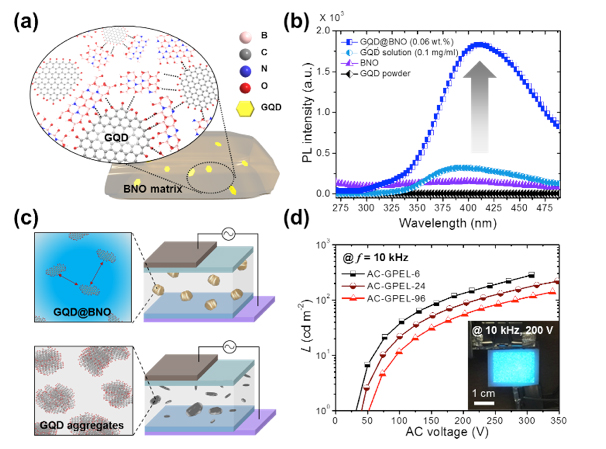As a research project of Global Frontier Program – KAIST Advanced Battery Center, Professor Seokwoo Jeon’s research team is working on the development of a graphene quantum dots (GQDs) based light-emitting devices by improving the photoluminescent property of GQDs. The project was started in 2016 to develop highly efficient solid-state photoluminescent GQDs as active materials for electroluminescent (EL) devices. Emerging GQDs have attracted significant attention for use as a next-generation EL material due to their biocompatibility, low-cost fabrication, and excellent optical properties. However, GQDs in the solid-state show complete loss of photoluminescence (PL) due to the π-interaction induced aggregation-caused PL quenching, and thus cannot serve as EL materials for any type of solid-state EL devices.
Herein, the research team demonstrated a novel, simple approach to build efficient solid-state photoluminescent GQD embedded in boron oxynitride powder (GQD@BNO) for a highly bright alternating-current powder electroluminescent (ACPEL) device. Due to the effective dispersal of GQDs in the BNO matrix, the aggregation could be significantly suppressed, resulting in high photoluminescence quantum yield (PL-QY) of up to 36.4 %, which is eight-fold higher than that of pristine GQDs in water. The PL-QY enhancement results from an increase in the spontaneous emission rate of GQDs due to the surrounding BNO matrix, which provides a high refractive index material and fluorescence energy transfer from the larger gap BNO donor to the smaller gap GQD acceptor. Finally, the efficient dielectric environment of the BNO matrix makes GQD@BNO an ideal active material for use in ACPEL devices, with the luminance of the first working GQDs-based ACPEL device exceeding 283 cd m-2.

This work affords the valuable contribution of precisely designing a wider gap matrix material with a higher refractive index for higher PL-QY, as well as controlling the dielectric environment for efficient field-driven excitation and the results herein will provide an important guideline for high-performance GQD based EL devices.
Prof. Seokwoo Jeon (Department of Materials Science and Engineering)
Mr. Minsu Park (Department of Materials Science and Engineering)
Homepage: http://fdml.kaist.ac.kr
E-mail: jeon39@kaist.ac.kr, voltare@kaist.ac.kr






